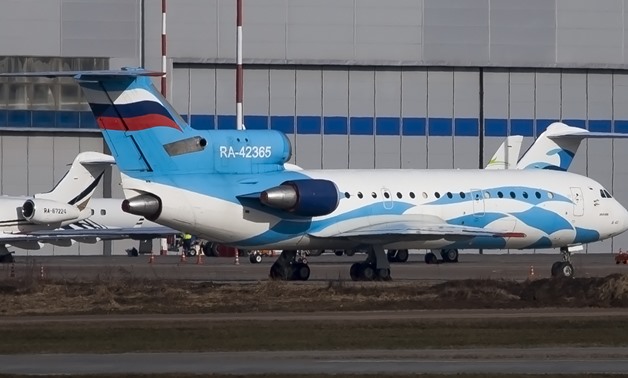
Sirius Aero's plane model RA-42365 - courtesy of Papas Dos
CAIRO – 17 February 2018: Sirius Aero, the largest Russian airline of business aviation, announced on Friday that it has obtained the government's permission to launch its first commercial passenger flight from Moscow to Cairo since October 2015.
Russian President Vladimir Putin approved the resumption of regular air traffic between Moscow and Cairo on January 4 after the Egyptian authorities strengthened security measures at the Cairo International Airport, in compliance with Russian demands.
However, Russia has not declared yet the resumption of its flights to Egyptian resorts, such as Sharm el-Sheikh and Hurghada, both of which are popular with Russian tourists.
On February 9, Russian Transport Minister Maxim Sokolov said that commercial passenger flights between Cairo and Moscow will resume on February 20, according to Russia's international news agency Novosti.
To understand the impact of resuming air links, one should know how could Egypt reach this moment?
Airbus A321
In October 2015, the Airbus A321, operated by Metrojet, crashed over the Sinai Peninsula, which was carrying Russian tourists returning from the Red Sea resort of Sharm el-Sheikh to St. Petersburg, killing all 224 on board.
Although Egypt-Russia investigations so far have not revealed the reason behind the crash, Russia, along with some other countries, had decided to suspend direct flights to Cairo and Sharm El-Sheikh for indefinite period. The decision decimated Egypt's vital tourism industry.
The tourism sector is one of Egypt’s main foreign currency earners, which has suffered badly from the travel ban that turned the once 100 percent occupied resorts to empty buildings.
Tourist inflow to Egypt peaked in 2010, when 14.7 million tourists visited the country, but the number fell to 4.5 million in 2016.
Russian and British tourists capture the largest portion of tourist inflows to Egypt; According to the Central Agency for Public Mobilization and Statistics (CAPMAS), the Russian tourist inflow to Egypt reached its peak in 2014, with tourists recording 3.1 million. Following the Russian plane crash, this number plummeted to 2.38 million in 2015.
The British tourist inflow used to range between 800,000 to one million tourists, but this number also declined after the suspension of flights to Sharm El-Sheikh. British flights are now limited to the tourist landmarks in the Red Sea and the Upper Egyptian cities of Luxor and Aswan.
Government efforts
During the 28-month air traffic suspension, a lot of false reports about the expected resumption of direct flights between Egypt and Russia were circulated in the media, making Egyptians doubt if this issue will find any end.
Through that period, the Egyptian government spared no effort to settle the case, using all diplomatic capabilities to speed negotiations with the Russian side, as well as other countries that imposed a ban on direct flights to Egypt.
Russian authorities always stressed that the resumption of flights would only be possible after Egypt satisfies all the demands made by Russian experts on ensuring security at domestic airports.
Since the crash, Egypt has been implementing new, tighter security measures at all of its airports to meet the Russian demands for the resumption of flights, with multiple visits by Russian security to behold changes implemented by the government.
During these visits, the Russian side affirmed that Egyptian aviation authorities have made significant progress in complying with Russia’s aviation safety requirements.
On December 11, Russian President Vladimir Putin visited Cairo for the second time since President Abdel Fatah Al-Sisi was sworn into office in May 2014. The visit showed increasing interest from Moscow to boost cooperation with Egypt after the bilateral relations have been up and down.
Asked about the return of direct flights to Egypt, Putin said “The Russian security services have reported to me that, on the whole, we are ready for opening the direct air link between Moscow and Cairo ... This would require signing a corresponding intergovernmental protocol.”
On December 15, Egyptian Civil Aviation Minister Sharif Fathi travelled to Moscow and met Russian Transport Minister Maxim Sokolov.
The two ministers signed an air security agreement that set the required procedures to pave the way for resuming Egypt-Russia air traffic.
“The first flight will likely be launched in February,” said Sokolov.
Egypt’s tourism recovers
There are indicators that suggest that tourism will bounce back, with the Ministry of Tourism announcing that tourist numbers are estimated at 8 million by the end of 2017, compared to 4.5 million tourists last year. How this can be possible?
The capacity of South Sinai’s hotels, including Sharm El-Sheikh, represent 35 percent of the total hotel capacity in Egypt, estimated at 225,000 rooms, of which about 65,000 rooms are in the Red Sea, 30,000 in Greater Cairo, and the rest in other provinces.
It means that the majority of Egypt’s hotel capacity lies outside the banned region. However, South Sinai represents 40-45 percent of Egyptian annual tourism income, and it can add $12 billion annually.
Meanwhile, the ministry said in a previous statement that a noticeable influx of Asian tourists started flocking to Cairo, Luxor and Aswan. The Asian visitors have mitigated the negative effects of the absence of Russian and British tourists.
China’s top public travel agency, China International Travel Service, reported a 58 percent increase in tourists flying to Egypt in 2016 compared to 2015, while Japan’s HIS travel agency said the number of tourists heading to Egypt was multiplied by four to five times last year.
The boom in Asian interest may be a result of the World Tourism Organization's decision to name Luxor the world’s tourism capital of 2016.
According to CAPMAS, the number of tourists who visited Egypt in fiscal year 2016/17 rose by 259,700 tourists to 732,700 tourists.
The return of Russian flights and tours could be a massive boost to tourist numbers that reached 5.3 million tourists in 2016, compared to 14.7 million visitors in 2010. However, it should be noted that the industry is already recovering gradually.

Comments
Leave a Comment